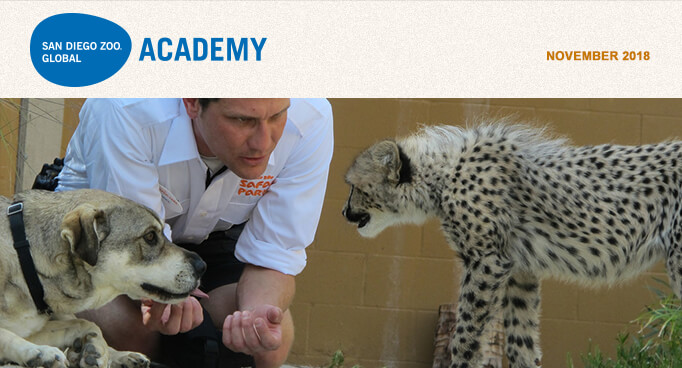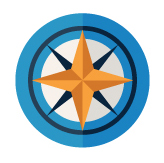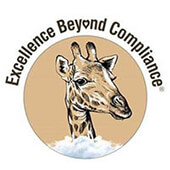 |
Career Path
 You know it is true. Competition for zoo and aquarium jobs in animal care is intense. In San Diego, we typically receive 150 to 200 applications for every animal care position that we post. In our amazing profession, animal managers have the luxury of hiring only the top people. So, how can you break into the profession or advance your career in this intensely competitive environment? You know it is true. Competition for zoo and aquarium jobs in animal care is intense. In San Diego, we typically receive 150 to 200 applications for every animal care position that we post. In our amazing profession, animal managers have the luxury of hiring only the top people. So, how can you break into the profession or advance your career in this intensely competitive environment?
From the outset, the animal care courses found in the Academy catalog were designed to create a career training track. The first series of courses that we built, the 13 Fundamentals courses, were designed with that in mind.
When the Academy began, I asked our animal care managers and curators what information they wanted the ideal new hire to know on their very first day. The answers drove the creation of the 13 Fundamentals courses, which are: Zoonotic Disease Prevention and Biosecurity, Government Regulations and Compliance, Working Safely in a Dangerous Environment, Fundamentals of Animal Learning, Operant Conditioning, Nutrition, Record Keeping, Enrichment, Ethics, Safe Handling and Restraint, Disaster Preparedness, Life Support Systems, and Elephant Management.
The second group of courses, the Intermediate series, is about halfway through production. The current courses in this series are: Animal Welfare, The Science Supporting Breeding and Transfer Plans, Exhibit Design, Animal Ambassador Management, and Neonatal Mammal Care Part 1. In 2019, five more Intermediate courses are scheduled for production.
For those looking to break into the profession or for advancement, here is some great news. The Academy has a large portion of zoos, aquariums, and related professional associations as institutional subscribers, as well as a growing number of colleges and universities. Academy animal care courses are fast becoming the profession's standard in animal care training. So, why wouldn't you include these courses on your resume?
Whether you are early in your career path or seeking advancement, if you have taken many or all of these courses, we recommend adding them to your resume. Why? We receive regular feedback from many zoo directors and curators who interview and hire professional staff. Resumes listing completed Academy courses are given added weight when managers make the difficult decision to select one candidate over another. And why not? These managers realize that you have already shown initiative and made the effort to take these courses. This is a benefit to both you and them. For you, it might provide that small but all-important advantage over another qualified applicant.
The Academy has learned of several instances where a hiring decision came down to the fact that one applicant included the list of Academy courses they had already taken and passed, and the other applicant who didn't. The path is clear.
For questions related to this article, please contact Gary Priest, San Diego Zoo Global Academy, at gpriest@sandiegozoo.org.
|
Academy News
 San Diego Zoo Global Academy Puts the Zoo of Chehaw Park in the Spotlight San Diego Zoo Global Academy Puts the Zoo of Chehaw Park in the Spotlight
The Zoo of Chehaw Park in Albany, Georgia is part of the Academy's collaborative learning environment!
New Tool and Feature for Subscribers on the Academy Platform!
Assessments allow you to uncover learning needs and gaps, and then use those results to develop individualized training plans for each learner in your organization. With assessments, you create a list of questions and sort them into competencies, focused on what you want to discover about your learners. Scores can be applied and adjusted for each competency, which you can then use to create individualized training plans for each learner.
For more information on the Assessments tool, click here
For more information about Assessments, please contact Linda Duca, CypherWorx, at lduca@cypherworx.com.
Administrator's Users Group Webinar
 Please join us for the Administrator's Users Group Webinar, hosted by Academy partner CypherWorx. The next webinar is Wednesday, November 21, at 11 a.m. PDT. Please join us for the Administrator's Users Group Webinar, hosted by Academy partner CypherWorx. The next webinar is Wednesday, November 21, at 11 a.m. PDT.
Register for this webinar here.
After registering, you will receive a confirmation email containing information about joining the webinar.
Revised Great Apes Course: Now in Three Parts
Interpreters, educators, docents, and guides have a new way to gain mastery over information about the great apes. We've taken the original course material and segmented it into three separate modules. Learners can do one, two, or all three. The shorter modules, each with a narrower scope, allow for a more focused approach to the material.
Great Apes 1 covers the physical characteristics, distribution, and habitats of the great apes, and it prepares the learner for the second module. Great Apes 2 covers great ape ecology and behavior. Great Apes 3 includes information on great ape reproduction and conservation. Each module has its own mastery test, and, like the original course, each module includes abundant photos, video, and self-assessment.
Another benefit of the Great Apes series is that it is designed in a new format that will run on your desktop computer, laptop, tablet, or even your phone—anywhere you have an internet connection! We're excited to share these newly formatted courses with you on San Diego Zoo Global Academy. Look for a new three-part Reptiles series, which will be posted by the end of this year.
To view a sample of the newly revised Great Apes course (now three modules), please click here.
For questions related to this article, please contact Donna Parham, San Diego Zoo Global, at dparham@sandiegozoo.org. |
Academy Contributors
 Getting Better All the Time: Serving Gratefully Is the Highest Form of Giving Thanks Getting Better All the Time: Serving Gratefully Is the Highest Form of Giving Thanks
By James F. Gesualdi
To keep ahead, each one of us, no matter what our task, must search for new and better methods— for even that which we now do well must be done better tomorrow.
—James F. Bell
We make a living by what we get, we make a life by what we give.
—Sir Winston Churchill
Make time to give thanks. Express gratitude. Come together. These are beautiful things. It is wonderful that one day each year is dedicated to giving thanks. Anticipation of this lovely commemoration extends the gratitude mindset. We can sow more good in this world by making thanks-giving, giving thanks, and serving gratefully a daily practice.
Giving, like caregiving—serving animals and their interests and well-being—gets us into positive action, generating positive results, and even more positive action. Improving and protecting animals' lives is such an outcome, and a most worthy one at that.
Giving, like caregiving, lifts up other living beings, raises our consciousness and that of others, while nourishing our souls.
Giving, like caregiving, builds awareness, develops character, and refines skills so that we can more effectively do even more good.
Positive means for giving and serving gratefully can be found in the Principles of Constructive Engagement (Turning Challenges into Opportunities: the Principles of Constructive Engagement, November 2015, available at the Academy newsletter archive, which offers in part:
Be grateful that you can change yourself for the better and, in doing so, help animals. We are all very fortunate to be able to use and improve ourselves in order to better serve and help animals. Be ever grateful, continuously improve, and make an even greater difference in serving animals and their interests.
Giving thanks for the opportunity to serve, and for those other souls who serve as well (including those who have helped us along the way), positively reinforces all the good emanating from giving and serving itself. Indeed, serving gratefully is the highest form of thanks-giving, and we should steadfastly maintain this consciousness, as we fulfill the caregiving responsibilities we are blessed and challenged to have entrusted to us.
New USDA Agency Bear Care Topics on Improving Bears' Lives
The United States Department of Agriculture, Animal and Plant Health Inspection Service, Animal Care has issued four aids geared towards enhancing bear welfare:
The agency's publication of these bear care aids warrants gratitude for several reasons:
- Guidance: Within the Animal Welfare Act regulations, bears are covered under the broad catch-all of performance-based standards relating to a vast array of "other warm-blooded animals," so these aids provide concrete examples of ideas to consider in addressing very general requirements, and in some instances doing more than legally required to enhance bear welfare.
- Taking stock, getting better: Even zoological organizations with good bear welfare can use the aids to take stock of their programs and pinpoint areas for additional evaluation or improvement.
- Sharing expertise to bolster regulatory effectiveness: Advanced zoological organizations might also generate informal comments or suggestions for the agency to consider in future efforts, to refine or better the aids or to develop similar materials for other species.
- Training: The bear care aids can also be used to train staff, particularly new team members.
- Helping other animals too: The bear care aids can be shared with all (non-bear) staff with a simple question—What ideas do these materials prompt for examining and improving the well-being of other species under your care?
A Further Note of Gratitude (for things visible and invisible)
A grateful heart overflowing with appreciation . . .
Thanks to you for reading, serving gratefully, and inspiring so many (myself included) with your good works on behalf of animals.
Happy Thanksgiving!
There are two kinds of gratitude: the sudden kind we feel for what we take; the larger kind we feel for what we give.
—Edwin Arlington Robinson
For more information on Excellence Beyond Compliance®, visit excellencebeyondcompliance.com.
© 2018 James F. Gesualdi, P.C. The opinions expressed herein are solely those of the author. This is not, nor should it be construed as, legal advice. |

|